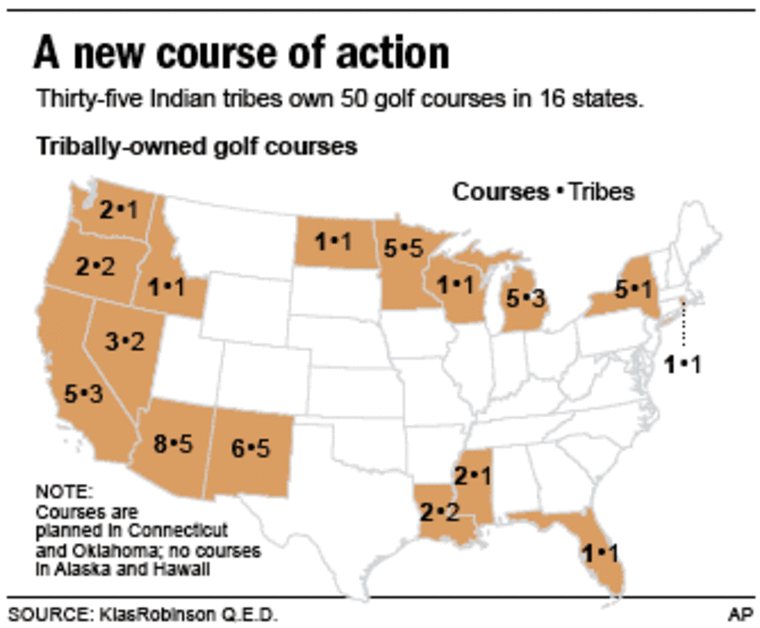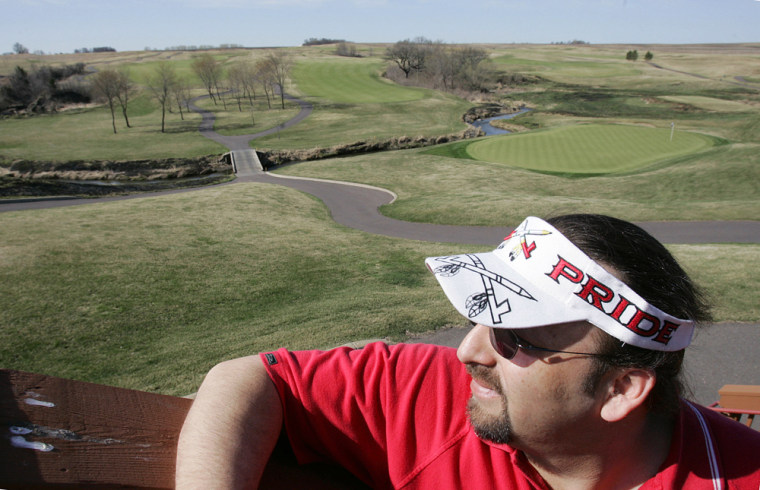Dacotah Ridge Golf Club sits deep inside Minnesota farm country, far from any four-lane highways and surrounded by towns with tiny populations.
But the remote location hasn't kept golfers from flocking to test their skills against the stiff winds, rolling hills and demanding greens at the club, whose owner, the Lower Sioux Indian Community, just happens to operate the Jackpot Junction Casino Hotel a few miles up the road.
In Minnesota and elsewhere, American Indian tribes that have mastered the casino gambling trade are increasingly venturing into the golf course business. The immaculate layouts springing up around the country are routinely winding up on must-play lists of leading golf magazines.
"The native tribes that own casinos are realizing that you have to have something more than just a casino to bring guests in," said Henry Boulley, a member of Michigan's Sault Ste. Marie Tribe of Chippewa and the organizer of the Native American Cup golf tournament.
"When Native American tribes put up a course next to their resort, they don't put up just a run-of-the-mill course," he added. "They put up a really spectacular course."
There are more than 50 tribal-owned courses in 16 states, and another 20 or so are planned, according to KlasRobinson Q.E.D., a consulting firm that works with tribes. More than half are situated near casinos.
The building boom has been recent, with at least 40 percent of them constructed since the turn of the century.
Last spring, the Mashantucket Pequot Tribal Nation opened a highly touted 36-hole golf complex — one private course and one for the general public — adjacent to its Foxwoods Resort Casino in Connecticut.
In February, the Seneca-Cayuga Tribe rolled out a plan for a $400 million casino and golf resort in central New York.
‘Golfers are generally gamblers’
Next month, the first full season of play opens at The Meadows of Mystic Lake Golf Course owned by Minnesota's Shakopee Mdewakanton Sioux Community, which runs one of the Midwest's largest casinos.
"It brings in a different type of clientele," said Bill Rudnicki, the Shakopee tribe's administrator. "We want to be seen as a resort facility."
Golf and tribal casinos mix well, said Sean Hoolehan, the president of the 21,000-member Golf Course Superintendents Association of America. Hoolehan knows that well as superintendent of the Wildhorse Resort and Casino on the Umatilla Indian Reservation in Oregon.
"Gamblers aren't necessarily golfers, but golfers are generally gamblers," Hoolehan said. "It's a good bet that when you bring in golf groups you'll get some of them to spend time in the other facilities."
Many tribes don't leave that to chance, offering cut-rate packages to lure golfers and encourage them to check out the casino, too. At Dacotah Ridge, for instance, a night in the hotel, breakfast and a round of golf can run as low as $100 in the summer; the 18-hole rate by itself is $80 with a cart.

"Golf generally is a lousy business. Most courses don't make any money," said Brad Klein, Golfweek magazine's architecture editor. "Golf is designed to sell something. Usually it's real estate; in this case it's casino rooms. The golf itself is a loss leader."
Tribes closely guard their financial reports, making it difficult to measure how golf affects their balance sheets.
Brian Pendleton, former Lower Sioux general manager, said the tribe felt an immediate lift in revenue after Dacotah Ridge opened six years ago. People came from farther away — most players travel at least 90 miles — and reserved rooms at the casino hotel. Gamblers who stay overnight typically spend an additional four hours at slot machines and card tables, he said.
But just any golf course won't do. Tribes have gone all out and hired revered designers like Tom Fazio, Jerry Pate, Pete Dye and Rees Jones whose involvement can earn courses instant acclaim.
"They're willing to spend a lot more money on construction. They tend to be rather fancy, a little higher end and better maintained than most market courses," Klein said.
The $8 million Dacotah Ridge course came from Jones, who has designed more than 100 courses, some of which have hosted PGA championships and U.S. Open events.
Bob Larsen, one of the first players off the tee when the course opened its season last week, said Dacotah Ridge stands out from other courses he's played.
"It's so wide open. There's no worries about getting hit by another hole or anything like that," Larsen said. "Some (courses) seem like they're so compact that they had to struggle to get the other nine holes in there. You need a helmet to play golf."
"This caliber is just far and above," Larsen added.
